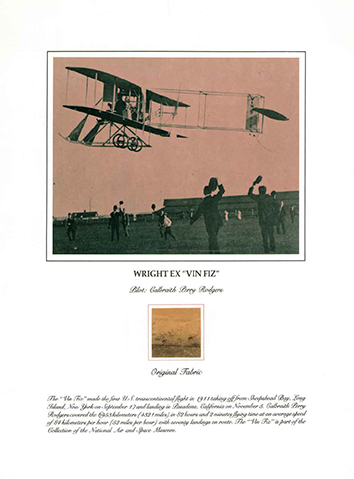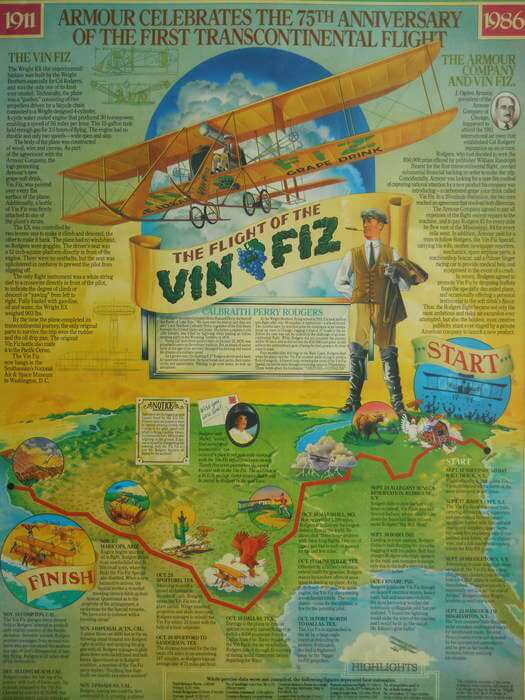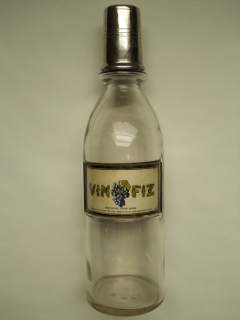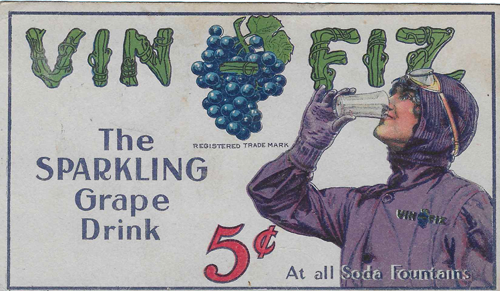
The Vin Fiz was built by Orville and Wilbur Wright – and is famous as the first aircraft to fly coast-to-coast with 70 landings and 12 crashes en route from New York to California! The aircraft image on this relic print is from an archival photo of the initial takeoff at Long Island in 1911 as the crowd cheers.
The flight was the media event of 1911, when flying across the U.S. was just an impossible dream. Only 2% of Americans had even seen an “aeroplane” then, so when it was reported by local newspapers that the Wright Vin Fiz would be passing overhead, school bells and factory whistles sounded. Everyone wanted to be outside to catch a glimpse of the “birdman” in a “newfangled flying machine.”
The Vin Fiz pilot, Cal Rodgers, had just learned to fly that summer at the Wright Brothers’ flying school in Dayton after only 90 minutes of instruction and was attracted by the Randolph Hearst Newspaper offer to pay $50,000 to anyone completing an Atlantic-to-Pacific flight in 30 days or less.
FREE SHIPPING ON TWO OR MORE RELIC PRINTS
The 32-year-old Rodgers recruited a sponsor to bankroll his flight – a Chicago-based company interested in promoting their new grape soda called Vin Fiz. They paid him $5 for every mile flown in return for advertising their soft drink. His Wright biplane was a flying billboard with “VIN FIZ – THE IDEAL GRAPE DRINK” painted on the under-wing . As he flew over towns and villages, Rodgers tossed out printed cards promoting the grape drink. The cards read: “GREETINGS FROM THE SKY – RODGERS IN THE VIN FIZ FLYER – FROM NEW YORK TO LOS ANGELES FOR HEARST $50,000 OCEAN TO OCEAN FLIGHT – VIN FIZ – THE IDEAL GRAPE DRINK – REFRESHING AND INVIGORATING – 5¢ – SOLD EVERYWHERE.”
On an early fall, Sunday afternoon in 1911, the 6 foot, 4 inch Rodgers climbed aboard his Wright biplane and coaxed it aloft from the racetrack at Sheepshead Bay, Long Island. The aircraft image on the Vin Fiz relic print shown above is from an archival photo of that very takeoff and shows spectators cheering him on to his final destination – California and the Pacific Ocean! It was an adventure few thought would be successful. As a good luck token, a bottle of Vin Fiz soda was tied to a wing brace of the aircraft.
The Vin Fiz Company provided a train with a private Pullman car for Rodgers and his wife to stay in each night. A second “hangar car” carried several “mechanicians” and was loaded with various spare parts purchased from
the Wright Brothers to repair the Vin Fiz while en route. In addition, the second car contained a Palmer-Singer automobile that would be used to locate and retrieve the pilot at the end of each day’s flight.
The third rail car was a day coach for photographers and newspaper reporters who filed daily reports on the flight’s progress. Local reporters would climb aboard and travel with the train long enough to get the latest news, then return to their hometown and write stories on the flight that everyone was talking about. Since there were no aerial charts or navigation aids in 1911, Rodgers used the railroad tracks as his “iron compass” and at the same time keeping him close to his support train – The Vin Fiz Special.
After 70 landings, 12 crashes, a run-in with an eagle and a near-fatal crash in California at Compton, Cal Rodgers finally completed the flight with casts on both legs and crutches strapped to the side of his battered biplane. Amazingly, also surviving the flight was the bottle of Vin Fiz soda that was strapped onto the aircraft in New York. Rodgers said he wouldn’t be happy until he reached the Pacific – and so he did, as he taxied into the surf at Long Beach.
Rodgers landed in a dozen states and his aerial adventure was called a “misadventure” by some because of the almost daily mishaps.
Flight begins September 17th at Long Island. Next morning, Rodgers clips tree on takeoff at Middletown, biplane plunges into chicken coop, grounded 3 days for repairs. Rodgers unhurt, chickens not so lucky.
Follows wrong set of railroad tracks from Scranton, emergency landing in oat field, farmer wants $25 for crop damage. Rodgers has no cash, spectators pass the hat, collect $4, avoiding first-ever aviation lawsuit.
Lands at Kent, plows into haystack, brushes hay from flying togs, accepts glass of buttermilk from farmer.
Lands at Grant Park in Chicago, admits too far behind schedule to collect Hearst $50,000 prize. Rodgers declares: “Fifty thousand dollars or fifty cents, I’ll be the first to cross the country in an aeroplane!”
Takes off from fairgrounds at Marshall, engine noise scares horses hitched to several wagons. Runaway, driverless buckboard strikes woman, breaking her leg.
Lands at Overland Park, acclaimed world’s longest distance flyer – 1,399 miles. Greeted by 300 spectators and 40 automobiles packed with Kansas City dignitaries and politicians, endless speeches. Rodgers announces: “Let’s go! We’re more than halfway there!”
Engine trouble, forced landing at McAlester. Finds out Philadelphia Athletics beat his New York Giants that day in World Series. Rodgers grumbles: “A bad day all around.”
On takeoff at Spofford, Rodgers swerves into giant cactus to avoid crowd of children. Wings and propellers destroyed. Crew repairs aircraft with help of local carpenter.
New Mexico
Lands at Lordsburg, greeted by enthusiastic spectators, boy takes cap from gas tank as souvenir. Local grocery store donates large potato to replace stolen gas cap.
Low flying Vin Fiz engine noise scares “big birds” at Tempe ostrich farm. Several birds panic, stick necks through wire fence in pens and are strangled. “Ostrich boys” tending birds yell at aircraft overhead.
Serious crash at Compton, broken ankles, cracked ribs, cuts and bruises. Laid up 35 days, flies last leg with both of his in casts. Lands at Long Beach, greeted by enthusiastic crowd of 50,000, bottle of Vin Fiz fastened to aircraft in New York survives flight.
Cal Rodgers – an aviation pioneer who said “why not” when others said “not possible.” Orville and Wilbur Wright – aviation icons with the American can-do spirit.
A 4-square inch swatch of the original wing fabric is attached to your 15″ x 20″ Wright Vin Fiz print, preserved when the Smithsonian Institution restored the aircraft. Also included is a Certificate of Authenticity signed by the Deputy-Director of the National Air and Space Museum along with 2 pages of colorful historical information and aircraft specs. A classic story and rare collectible for anyone interested in aviation relics – and the ultimate gift for an aviation enthusiast or pilot.
Our supply of the Wright Vin Fiz relic prints is limited to the fabric preserved when the aircraft was restored by the Smithsonian Institution.
 CLICK TO ENLARGE!1911 Liberty head V-nickel Our goal at Aviation Relic Prints is not only keeping aviation history alive for adults but to interest our kids in aviation at the same time. So, along with each Wright Vin Fiz relic print ordered, we are also offering for sale our very popular Vin Fiz Legacy Pack with 3 items in it. It’s meant to be – JUST FOR KIDS.
CLICK TO ENLARGE!1911 Liberty head V-nickel Our goal at Aviation Relic Prints is not only keeping aviation history alive for adults but to interest our kids in aviation at the same time. So, along with each Wright Vin Fiz relic print ordered, we are also offering for sale our very popular Vin Fiz Legacy Pack with 3 items in it. It’s meant to be – JUST FOR KIDS.
First item in the pack is a 1911 Liberty Head V-nickel – the year Cal Rodgers made his coast-to-coast flight. We don’t recommend spending it at the corner store because it’s a vintage, collectible coin – graded GOOD to VERY GOOD. In 1911, it was enough to buy a Vin Fiz grape soda.
Also included is a 15” x 20” color poster that was published in 1986 to celebrate the 75th anniversary of the Vin Fiz flight. Kids – and adults – like it for the colorful graphics and the amazing, sometimes amusing, story of Cal Rodgers and his cross-country adventure. The poster pictures 18 different mishaps that occurred during the flight – like this “incident” at Middletown, NY. “Attempting to clear telegraph wires on takeoff, the Vin Fiz hits a tree, plunges into chicken coop. Several fowl are killed, plane is virtually demolished. Rodgers not hurt, wires Wright brothers to send new parts.” And this “episode” that happened in Texas. “Offended by a farmer’s refusal to extend credit for gasoline, Rodgers rejects a bystander’s offer of assistance in starting up his plane. As he pulls down on the propeller to ignite the engine, the Vin Fiz starts taxiing across the farmer’s field. The crowd cheers – some for the airplane, a few for the pursuing pilot.”
 CLICK TO ENLARGE!Vin Fiz poster
CLICK TO ENLARGE!Vin Fiz poster CLICK TO ENLARGE!Vin Fiz crashes into chicken coop
CLICK TO ENLARGE!Vin Fiz crashes into chicken coop CLICK TO ENLARGE!Rodgers chases after Vin Fiz
CLICK TO ENLARGE!Rodgers chases after Vin Fiz CLICK TO ENLARGE!Grape scratch ‘n sniff stickers
CLICK TO ENLARGE!Grape scratch ‘n sniff stickers
Cal Rodgers was the descendant of two U.S. Navy war heroes. His family tree included Commodore Oliver Hazard Perry – the hero at the Battle of Lake Erie in 1813 and known for his bold statement: ”We have met the enemy and they are ours.” Another ancestor, Commodore Matthew Calbraith Perry, was famous for his key role in the treaty that established relations and opened trade with Japan in 1854.  CLICK TO ENLARGE! Cal Rodgers in the Vin Fiz Rodgers was also expected to distinguish himself in the military but that dream was impossible due to his near-total deafness as a result of having scarlet fever as a child. The 6’ 4” Rodgers was a risk-taker and satisfied his love of speed and competition by racing horses, yachts, motorcycles and automobiles. Then he saw one of the new “flying machines” and it was love at first flight. He said: “A man could become drunk with flying. Everything I’ve done up until now doesn’t matter.” In June of 1911 he was certified by Orville Wright after only 90 minutes of instruction. After buying a Model B for $5,000 from the Wright Brothers, he spent that summer barnstorming and distinguishing himself in flying competitions. His skill at an air meet in Chicago brought Rodgers to the attention of Vin Fiz Company officials who were looking for a way to introduce their new grape soda. His next adventure was to fly coast-to-coast and collect the $50,000 Hearst prize. However, Orville Wright told him: “We’ll sell you one of our aircraft, but they aren’t meant to take that kind of punishment. You won’t make it as far as Chicago.” Rodgers didn’t care what everyone said about the flight. “People said it was foolhardy for me to even try flying coast-to-coast. Foolhardy? Well, I hardly think I’m a fool, but will admit there’s no quit in me. I told my guys as long as they kept on repairing the Vin Fiz – I’d keep on flying. Fix ‘er up boys.” The rest is history! Since he didn’t complete his cross-country flight in the required 30 days, Rodgers couldn’t collect the Hearst prize money. However, the “dollars per mile flown” agreement with Mr. Armour amounted to $23,000 – the equivalent of over $550,000 today.
CLICK TO ENLARGE! Cal Rodgers in the Vin Fiz Rodgers was also expected to distinguish himself in the military but that dream was impossible due to his near-total deafness as a result of having scarlet fever as a child. The 6’ 4” Rodgers was a risk-taker and satisfied his love of speed and competition by racing horses, yachts, motorcycles and automobiles. Then he saw one of the new “flying machines” and it was love at first flight. He said: “A man could become drunk with flying. Everything I’ve done up until now doesn’t matter.” In June of 1911 he was certified by Orville Wright after only 90 minutes of instruction. After buying a Model B for $5,000 from the Wright Brothers, he spent that summer barnstorming and distinguishing himself in flying competitions. His skill at an air meet in Chicago brought Rodgers to the attention of Vin Fiz Company officials who were looking for a way to introduce their new grape soda. His next adventure was to fly coast-to-coast and collect the $50,000 Hearst prize. However, Orville Wright told him: “We’ll sell you one of our aircraft, but they aren’t meant to take that kind of punishment. You won’t make it as far as Chicago.” Rodgers didn’t care what everyone said about the flight. “People said it was foolhardy for me to even try flying coast-to-coast. Foolhardy? Well, I hardly think I’m a fool, but will admit there’s no quit in me. I told my guys as long as they kept on repairing the Vin Fiz – I’d keep on flying. Fix ‘er up boys.” The rest is history! Since he didn’t complete his cross-country flight in the required 30 days, Rodgers couldn’t collect the Hearst prize money. However, the “dollars per mile flown” agreement with Mr. Armour amounted to $23,000 – the equivalent of over $550,000 today.
It was a one-of-a-kind aircraft built especially for Rodgers and was designated the Wright EX – for experimental. The aircraft weighed 903 pounds and as Orville Wright remarked: “Six good men could carry it coast-to-coast.” It had a 31 foot wingspan and was powered by a 35 hp Wright engine, giving it a top speed of 55 mph. The 15 gallon gravity-fed fuel tank allowed for 3½ hours flying time and the engine had 2 speeds – full speed ahead and off. Seat belts had not yet been invented, so the 12 inch square “drivers seat” was covered with corduroy to help Rodgers from sliding around so easily while airborne. The only on board “navigation instrument” was an 8” string from his wife’s corset which was attached to a cross wire in front of him to indicate when the aircraft was in a climb, a descent or a bank. Rodgers agreement with the Vin Fiz Company required him to advertise their new grape soda on the aircraft, making it the very first flying billboard. On the bottom of the lower wing was painted: VIN FIZ – THE IDEAL GRAPE DRINK and the Vin Fiz logo – a bunch of purple grapes. It was a challenge for Rodgers and his crew to keep spectators away from the aircraft when it landed because, in their enthusiasm, they would paw it and often try to snatch a souvenir. At locations where he was expected to land, warnings were posted on trees and fence posts. “NOTICE: Owing to the great speed with which a flying machine travels, it continues fully 100 feet after alighting on the ground. If anyone is injured by disregarding this warning, both the Vin Fiz Co. and Mr. Rodgers disclaim all blame for the accident.” All of America was following the Vin Fiz flight in the newspapers. When Rodgers passed over Parsons, Kansas, there were 10,000 people assembled – hoping to see the “new-fangled aeroplane.” One of them was a 13-year-old boy – Claude Ryan. He stared in amazement at the aerial wonder and promised himself that he too would one day fly. He went on to found Ryan Aeronautical, the company that built the “Spirit of St. Louis” – the aircraft Charles Lindbergh flew non-stop across the Atlantic in 1927. In 1910, two small factories were erected in Dayton by the Wright Brothers. Only about 120 planes were built there, one of which was the Vin Fiz. Wilbur Wright died unexpectedly in 1912 at age 45 and Orville sold his share in the business in 1915.
 CLICK TO ENLARGE!Vintage Vin Fiz syrup bottle with measuring cap. At an international air meet in Chicago in August of 1911, Rodgers placed first in the endurance competition with 27 hours. There he met J. Ogden Armour, owner of the Chicago-based Armour Meat Packing Company. Rodgers needed a sponsor for his cross-country flight and Mr. Armour wanted to introduce his new Vin Fiz Company’s grape soda to the country. After a 20 minute discussion, Armour agreed to pay him for each mile flown on the coast-to-coast flight – $5 east of the Mississippi and $4 west of the river. Armour would also provide 3 train cars to follow and support the flight with Vin Fiz advertising decorating both the aircraft and rail cars. In addition, when flying over towns and villages, Rodgers was expected to toss out cards celebrating the benefits of drinking the new grape soda. The cards read: ”GREETINGS FROM THE SKY – RODGERS IN THE VIN FIZ FLYER – FROM NEW YORK TO LOS ANGELES FOR HEARST $50,000 OCEAN TO OCEAN FLIGHT – VIN FIZ – THE IDEAL GRAPE DRINK – REFRESHING AND INVIGORATING – 5 CENTS – SOLD EVERYWHERE. Each time a crowd gathered to watch a landing or takeoff, a company spokesman would grab his megaphone and enthusiastically sing its praises: “Vin Fiz is the finest blend of grape juices, sold at all soda fountains, only five cents.”
CLICK TO ENLARGE!Vintage Vin Fiz syrup bottle with measuring cap. At an international air meet in Chicago in August of 1911, Rodgers placed first in the endurance competition with 27 hours. There he met J. Ogden Armour, owner of the Chicago-based Armour Meat Packing Company. Rodgers needed a sponsor for his cross-country flight and Mr. Armour wanted to introduce his new Vin Fiz Company’s grape soda to the country. After a 20 minute discussion, Armour agreed to pay him for each mile flown on the coast-to-coast flight – $5 east of the Mississippi and $4 west of the river. Armour would also provide 3 train cars to follow and support the flight with Vin Fiz advertising decorating both the aircraft and rail cars. In addition, when flying over towns and villages, Rodgers was expected to toss out cards celebrating the benefits of drinking the new grape soda. The cards read: ”GREETINGS FROM THE SKY – RODGERS IN THE VIN FIZ FLYER – FROM NEW YORK TO LOS ANGELES FOR HEARST $50,000 OCEAN TO OCEAN FLIGHT – VIN FIZ – THE IDEAL GRAPE DRINK – REFRESHING AND INVIGORATING – 5 CENTS – SOLD EVERYWHERE. Each time a crowd gathered to watch a landing or takeoff, a company spokesman would grab his megaphone and enthusiastically sing its praises: “Vin Fiz is the finest blend of grape juices, sold at all soda fountains, only five cents.”
 CLICK TO ENLARGE!Vintage Vin Fiz Postcard The Vin Fiz Company recruited Harriet Quimby as spokeswoman for their grape soda. She too was an American aviation pioneer, famous as the first licensed female pilot and the first woman to fly the English Channel. Her channel crossing was noteworthy but second page news because, the day before, the Titanic sank. Her distinctive purple aviator uniform and image was seen in Vin Fiz advertising nationwide.
CLICK TO ENLARGE!Vintage Vin Fiz Postcard The Vin Fiz Company recruited Harriet Quimby as spokeswoman for their grape soda. She too was an American aviation pioneer, famous as the first licensed female pilot and the first woman to fly the English Channel. Her channel crossing was noteworthy but second page news because, the day before, the Titanic sank. Her distinctive purple aviator uniform and image was seen in Vin Fiz advertising nationwide.
Vin Fiz was sold at all soda fountains but didn’t compete very well with another new soft drink of the time – Coca Cola. It was described by some as tasting like “river swill” and by others as having a “laxative effect.” And one critic declared: “You have to sneak up on it to get it down.”
After his record-setting flight, Cal Rodgers was a national celebrity. He was honored at countless events, including a dinner at which President Taft presented him with a gold medal commemorating his “unparalleled feat of aeronautics.” At Pasadena’s Tournament of Roses parade in January of 1912, Rodgers flew at 700 feet and dropped flowers over the cheering crowd of 150,000 admirers. The Wright Vin Fiz was stored in a warehouse but his first aircraft, a Wright Model “B”, was tuned up and made ready for flight. Rodgers used that aircraft – “Old No. 27” – to give passengers a brief $2 ride over the ocean by the pier at Long Beach. One day in early April, he was troubled by a strange engine noise and decided to fly a trial run before taking up another passenger. While aloft at 200 feet over the surf, he saw a flock of sea gulls ahead. He dropped the nose to avoid them but one of the birds lodged in the tail section, causing him to lose control of the aircraft. It crashed in two feet of water at the beach and the engine slammed into him, breaking his neck. He was killed instantly. Rodgers’ casket was placed in open view on a rail car which retraced the route he had flown just 4 months earlier. The train slowed at locations where he had landed on his east to west journey while crowds paid their respects as the flag-draped coffin passed by.
We are interested in acquiring any early items relating to the Wright Vin Fiz aircraft, the Vin Fiz Company and Cal Rodgers. They may be used in a movie presenting the story of the 1911 coast-to-coast flight. Anything will be helpful, including Vin Fiz advertising materials, bottles or items from the Armour and Vin Fiz Company. Any written or anecdotal personal narratives, letters, photos, newspaper articles or other material relating to Cal Rodgers, his family and his flight would be of interest. Please contact us at [email protected]